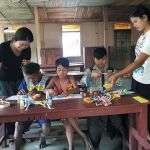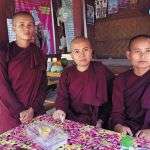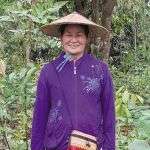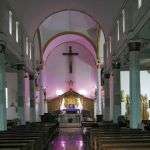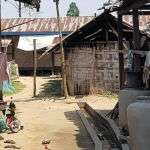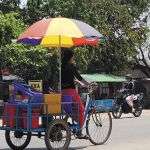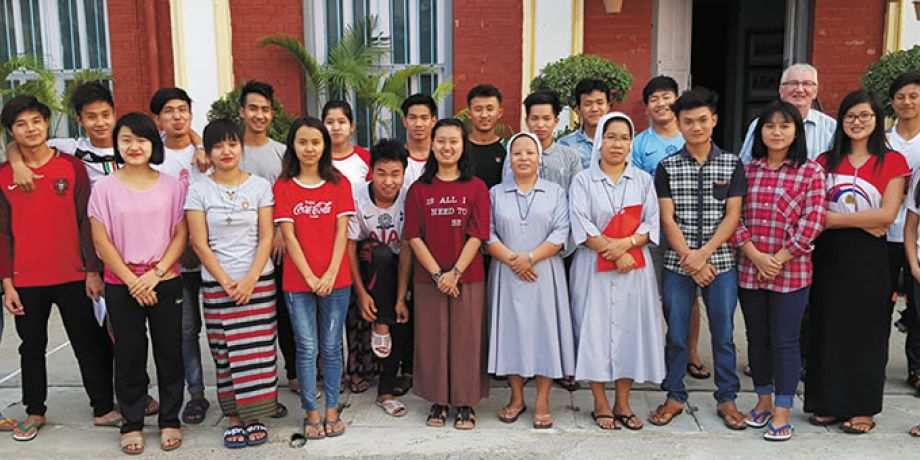
A Hopeful Future
It was a great privilege to have had the opportunity to visit Myanmar (formerly Burma) this year. As a Columban missionary it is a country that has always fascinated me. Due to the tensions between Pakistan and India because of the incursion into Pakistan territory by India, I was forced to reroute my flight from Karachi to Dubai and then on to Bangkok and finally to Mandalay, Myanmar. When I finally did reach my destination in Mandalay, I was delighted to see the two familiar faces of Columban Sisters Kathleen Geaney and Cristita de Leon there to greet me. Mandalay Airport is an hour’s drive from the center of Mandalay city.
Columban History
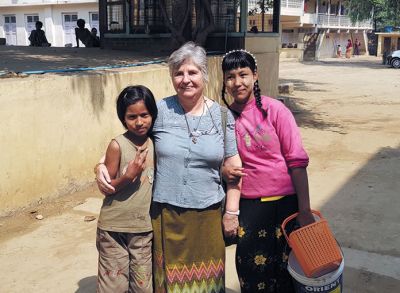
There has been a very strong and long Columban presence in Myanmar. This was disrupted for a number of years due to government regulations of not allowing foreign missionaries to minister in Myanmar. One has to admire the tremendous pioneering work done by both Columban Sisters and priests in the Kachin area. The territory in which they worked in Myitkyina is vast and had to be traveled on horseback or by walking long distances. The facilities at the time were indeed very primitive. During World War Two a number of religious people were interned in Mandalay. What very much endeared them to the people was their desire to stay with them when things became difficult. Many of the pioneering Columbans continued to stay on with the people long after they were due a vacation at home. To this day many of the older people still talk of the Columbans that they knew and how much their presence meant to them.
The Columbans finally had to leave in 1979 but not before leaving as their legacy a vibrant local Church in Myitkyina with its own native Kachin Bishop, Paul Grawng. Archbishop Paul is now retired and lives in Mandalay where he was Archbishop for a number of years. To this day he still retains his great appreciation for the work that Columbans did.
In 1979, when the Columbans bid their farewells, it was definitely thought to be a final decision. There would be no opportunity for missionaries to return. The schools had become nationalized. In the meantime, over the past fifteen years Columban priests, Sisters and lay missionaries have had a small presence in Mandalay, Myitkyina and Bhamo (Banmaw). The group is very international, with members from Ireland, the Philippines, Korea and Chile. Over the past seven years we have begun to accept students from Myanmar who wish to become Columban priests. Some are now in the Philippines studying and two more are getting ready to go.
The Role of the Military
Since Myanmar attained independence, it has for the most part been ruled by the military. While there is currently a semblance of democracy, the military has been criticized for the way that it has treated the Rohingya people and the Kachins. Many of the latter still continue to live in IDP (Internally Displaced Persons) camps in the dioceses of Myitkyina and Bhamo. Many of these camps are situated adjacent to church compounds, and one has to admire the tremendous dedication of the local church in their pastoral outreach to these displaced people. It is the wish of the people to return to their own piece of land from which they were forced out, but this will take a long time. Due to the tensions, travel in some areas is not allowed to missionaries.
The Friendliness and Deep Faith of the People
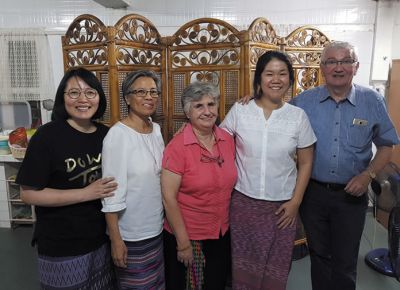 Myanmar is mainly Buddhist. During my stay there I had the opportunity to meet different groups. Compared to Pakistan and even in spite of the strong military influence, in Myanmar people seem to be more free. To see women riding scooters and motorcycles is unheard of in Pakistan. The people are not only friendly but also are extremely resilient and enterprising. It was very difficult for me to see women working on the roads under intense heat.
Myanmar is mainly Buddhist. During my stay there I had the opportunity to meet different groups. Compared to Pakistan and even in spite of the strong military influence, in Myanmar people seem to be more free. To see women riding scooters and motorcycles is unheard of in Pakistan. The people are not only friendly but also are extremely resilient and enterprising. It was very difficult for me to see women working on the roads under intense heat.
I had the opportunity, with the help of some local priests of Bhamo diocese, Frs. Paul and Michael, of visiting some of the IDP camps. Conditions are cramped and very severe. In spite of their hardships the people were most welcoming and gracious. In their cramped surroundings they had neatly piled wood for cooking, and they share common areas for cooking meals. During the day the men are out working in various jobs which are poorly paid. While nobody can condone the situations in which they find themselves they have that built-in graciousness of welcoming the stranger like myself.
During my stay I was deeply impressed by the deep faith of the people. The churches were full for Sunday liturgies. From the very youngest to the oldest, people fully participated in the singing and the prayers, all in the Kachin language. If the liturgies were long, and some were, the people did not seem to mind. So many of the older people would say that they owe a huge debt of gratitude to the pioneering Columbans for their faith which is now further developed by local church personnel.
A Variety of Ministries
Columbans are working in collaboration with the local church in a variety of ministries. During my visit I had the opportunity of seeing first-hand some of these ministries: interfaith dialogue, formation work, caring for the environment, working with youth, working with people with disabilities, running a Higher Education Center which gives students from economically poor backgrounds the opportunity to do a three-year degree course (I compliment the great work of Columban Fr. Neil Magill at the Center ), working with people with HIV/Aids, and running a Rebirth Center for young men addicted to drugs. I was amazed to discover that drugs are one of the biggest killers in Myanmar.
One could not help but be impressed by the ministries of Columban Sisters Teresa, Maria, Enda and Lucy all from Korea and Cristita de Leon from the Philippines with young people and in their outreach work with people with disabilities, some very severe. Together with a very dedicated group of teachers and parents, they spend quality time with the children. One has to admire the love of the mothers for the children. They are able to creatively bring out the hidden talents of these young people and minister to them with dignity and patience. The same could be said of other religious Sisters in their ministries to young children and vulnerable adults affected by HIV/Aids.
The Rebirth Center in Myitkyina
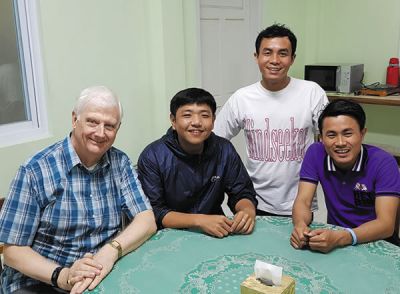 At the invitation of Columban Fr. Eamon Sheridan, I had the honor of accompanying the group of 40 young people in their twenties at the Rebirth Drug Rehabilitation Center on an outing to Tangphrey where the rivers meet. It was formerly a Columban parish and now the government, with China backing, is proposing to build a big dam which will destroy the homes and lands of so many people. If this is to materialize it will lead to further dislocation of people.
At the invitation of Columban Fr. Eamon Sheridan, I had the honor of accompanying the group of 40 young people in their twenties at the Rebirth Drug Rehabilitation Center on an outing to Tangphrey where the rivers meet. It was formerly a Columban parish and now the government, with China backing, is proposing to build a big dam which will destroy the homes and lands of so many people. If this is to materialize it will lead to further dislocation of people.
It was good to be part of this group even though I did not speak the Kachin language. They were about to finish a fifteen-week rehabilitation course and were to evaluate how the course went for them. It was their first time outside the Rebirth Center in fifteen weeks, and they were full of excitement as they traveled by bus. Many sat on the top of the bus on the journey. They brought their food with them which we all shared at lunch under the shade of a big tree.
We had to take a boat across to the island and grotto. On the way, the boat in which I was traveling hit a rock. It began to sway, and I must say that I was rather afraid. One of the young men was my guardian angel. He could sense my fear, and he clung on to me to make sure that I was okay. After a while, we had to transfer to another boat in mid water. After this, there was no further mishap.
The thing that really struck me about the day was that there was the distinct probability for many of them that when they graduated they would be under awful pressure from some of their peers to go back on drugs. This is a reality. They are always welcome back to the Rebirth Center to try again. At the celebration of the Eucharist, Fr. Eamon recalled how Jesus came to the rescue of the disciples when they feared that their boat was sinking as we did earlier in the day. He encouraged them to have faith in Jesus during the trials that they will encounter in life.
Another incident was very moving. Fr. Eamon, like all the Columbans in Myanmar, had to travel to Bangkok to renew his Visa. While he was there he bought some paints for one of the volunteers at the Center who is very creative in art. When he received the gift from Fr. Eamon he cried. He told him that this was the first time in his life that anybody had given him a gift. This young man was in his twenties. It made me realize how much I can take for granted.
On Easter Sunday morning, at the invitation of Fr. Eamon, I had the honor of giving the homily to the young people at the Rebirth Center. The occasion coincided with the horrific tragedies that took place in Sri Lanka earlier that morning as people gathered together in prayer to celebrate the Lord’s resurrection, the gift of new life. This tragedy made a deep impression on these young people–as it did on all of us and on the world.
Visit to the Hope Center in Myitkyina
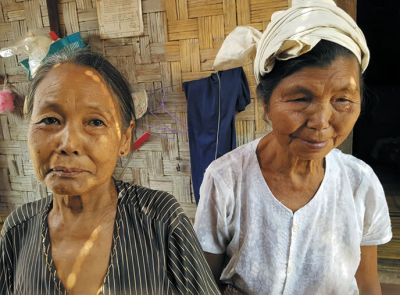 The Hope Center in Myitkyina was started by Columban Sister Mary Dillon. Our visit there was tinged with sadness. One of the staff members at the Center, a young mother of two, was killed the previous day in a road accident on her way home from work. The way in which the residents at the Center with HIV/Aids are being looked after is very encouraging. They are ministered to with great dignity by the Sisters and staff.
The Hope Center in Myitkyina was started by Columban Sister Mary Dillon. Our visit there was tinged with sadness. One of the staff members at the Center, a young mother of two, was killed the previous day in a road accident on her way home from work. The way in which the residents at the Center with HIV/Aids are being looked after is very encouraging. They are ministered to with great dignity by the Sisters and staff.
Interfaith Conversations and Dialogue
It was very heartening to see initiatives being made in promoting interfaith conversations. I had the pleasure of visiting with Sr. Kathleen Geaney at a Buddhist Monastery of nuns at the Baybin Center on the outskirts of Mandalay. One could sense the very special relationship that they had with each other.
On another occasion, I attended an afternoon session for young people at the CLAY Center in Myitkyina where there were speakers from the various faith traditions: Muslims, Hindus, Buddhists and Christians. On the way from Mandalay to Myitkyina I engaged in conversation with a young Buddhist monk who was one of the speakers at the Interfaith meeting. Another moving occasion was my visit with Sr. Kathleen to the Mahamuni Pagoda, the second largest in Myanmar. It attracts many devotees on a daily basis.
Visit to the Columban Graves in Bhamo and Myitkyina
Visiting the graves of Columbans who died in Myanmar was a very moving experience. In Bhamo I was accompanied by Bishop Raymond and the three Columban lay missionaries, Lenette, Lorna and Michael from the Philippines. As a mark of respect they brought roses and candles to place on the graves of the late Monsignor Patrick Usher, Tom Walsh, Tom McEvoy and Jim Fitzpatrick. Bishop Raymond recalled the great influence of Columban Fr. Jim Fitzpatrick who encouraged him to join the seminary.
In Myitkyina, together with Columban Fr. Pat O’Donoghue, Sr. Mary Ita O’Brien and John, a Columban seminarian, we visited the graves of the late John Walsh, tragically killed in an accident, as well as John Dunlea and Sr. Mary Celestine, a Columban Sister from Ireland. These were special moments during my visit to Myanmar. It was good to have had the opportunity for some quiet time to give thanks to God for their lives and ministry. At both places we prayed for all Columbans who had served in Myanmar.
With Grateful Appreciation
I was very privileged to have had the opportunity to visit Myanmar and to have experienced the commitment of the Columbans and the local Church in their outreach work– especially with the poor and the very vulnerable. They carry out their work with great compassion and gentleness.
My thanks to Columban Fr. Pat O’Donoghue for his graciousness to me during my time at the Columban House in Myitkyina. I enjoyed the conversations I had with Sr. Mary Ita. We were able to recall many memories going back over many years. I am deeply grateful to all for the genuine and warm welcome which I received from so many people, especially from Archbishop Paul, Bishop Francis, Bishop Raymond, Fr. Leo and the local priests and Sisters. Because of the intense heat, the conditions under which they work for much of the year are very trying and demanding.
It was very fitting that on my last night we celebrated a moving Liturgy in the beautiful Prayer room of the Columban Sisters in Mandalay followed by a celebratory meal. I was sad to leave Myanmar, but deeply grateful. It is hopeful for the future to see the presence of three young Columban priests, Jehoon from Korea, Kurt from the Philippines and Rafael from Chile. Let us continue to keep them all and the people of Myanmar in our prayers.
Columban Fr. Pat Raleigh lives and works in Ireland.
